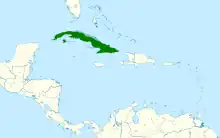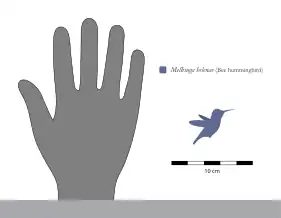| Bee hummingbird | |
|---|---|
_adult_male_in_flight-cropped.jpg.webp) | |
| Male in flight | |
_female_in_flight.jpg.webp) | |
| Female in flight | |
| Scientific classification | |
| Domain: | Eukaryota |
| Kingdom: | Animalia |
| Phylum: | Chordata |
| Class: | Aves |
| Clade: | Strisores |
| Order: | Apodiformes |
| Family: | Trochilidae |
| Genus: | Mellisuga |
| Species: | M. helenae |
| Binomial name | |
| Mellisuga helenae (Lembeye, 1850) | |
 | |
The bee hummingbird, zunzuncito or Helena hummingbird (Mellisuga helenae) is a species of hummingbird, native to the island of Cuba in the Caribbean. It is the smallest known bird.[3][4]
Description
The bee hummingbird is the smallest living bird.[3][4] Females weigh 2.6 g (0.092 oz) and are 6.1 cm (2+3⁄8 in) long, and are slightly larger than males, which have an average weight of 1.95 g (0.069 oz) and length of 5.5 cm (2+1⁄8 in).[3] Like all hummingbirds, it is a swift, strong flier.
The male has a green pileum and bright red throat, iridescent gorget with elongated lateral plumes, bluish upper parts, and the rest of the underparts mostly greyish white.[4][5] Compared to other small hummingbirds, which often have a slender appearance, the bee hummingbird looks rounded and plump.[5]
Female bee hummingbirds are bluish green with a pale gray underside.[5] The tips of their tail feathers have white spots. During the mating season, males have a reddish to pink head, chin, and throat. The female lays only two eggs at a time, each about the size of a coffee bean.[4]
The bee hummingbird's feathers have iridescent colors, which is not always noticeable, but depends on the viewing angle. The bird's slender, pointed bill is adapted for probing deep into flowers. The bee hummingbird feeds mainly on nectar, by moving its tongue rapidly in and out of its mouth. In the process of feeding, the bird picks up pollen on its bill and head. When it flies from flower to flower, it transfers the pollen. In this way, it plays an important role in plant reproduction. In one day, the bee hummingbird may visit 1,500 flowers.[6] It is a diurnal bird that can fly at 40–48 km/h (22–26 kn; 11–13 m/s), and it beats its wings 80–200 times per second, which allows it to remain stationary in the air to feed on flowers. The bee hummingbird lives up to seven years in the wild, and 10 years in captivity.[3]
The bee hummingbird has also been described as "the smallest dinosaur".[7] This characterization is based upon the recognition that birds are, in fact, a living form of dinosaurs (or, strictly speaking, avian dinosaurs),[8] and no smaller bird or non-avian dinosaur has been found in the fossil record.[7]
 Size of M. helenae compared to a human hand
Size of M. helenae compared to a human hand_adult_male_non-breeding.jpg.webp) Adult male, Cuba
Adult male, Cuba_immature_male.jpg.webp) Juvenile male
Juvenile male
Diet
.jpg.webp)
The bee hummingbird has been reported to visit ten plant species, nine of them native to Cuba. These flowers include Hamelia patens (Rubiaceae), Chrysobalanus icaco (Chrysobalanaceae), Pavonia paludicola (Malvaceae), Forsteronia corymbosa (Apocynaceae), Lysiloma latisiliquum (Mimosaceae), Turnera ulmifolia (Passifloraceae), Antigonon leptopus (Polygonaceae), Clerodendrum aculeatum (Verbenaceae), Tournefortia hirsutissima (Boraginaceae), and Cissus obovata (Vitaceae).[9] They occasionally eat insects and spiders. In a typical day, bee hummingbirds will consume up to half their body weight in food.
Habitat and distribution
The bee hummingbird is endemic to the entire Cuban archipelago, including the main island of Cuba and the Isla de la Juventud in the West Indies.[3][10] Its population is fragmented; it is found in Cuba's mogote areas in Pinar del Río Province[11] and more commonly in Zapata Swamp (Matanzas Province) and in eastern Cuba, with reference localities in Alexander Humboldt National Park and Baitiquirí Ecological Reserve (Guantánamo Province) and Gibara and Sierra Cristal (Holguín Province).[12]
Breeding

Bee hummingbirds reach sexual maturity at one year of age. Male bee hummingbirds court females with sound from tail‐feathers, which flutter during display dives.[13] The bee hummingbird's breeding season is March–June, with the female laying one or two eggs.[14]
Using strands of cobwebs, bark, and lichen, female bee hummingbirds build a cup-shaped nest about 2.5 cm (1 in) in diameter, lining the nest with soft plant fibers. Branches in mature, leafy jucaro (Terminalia buceras) and juvenile ocuje (Calophyllum antillanum) trees are commonly used for nest building. After completion of the nest, the eggs are incubated for 21 days by only the female, followed by 2 days of hatching, and 18 days of care by the mother. Over the final 4–5 days of care, juvenile bee hummingbirds practice their flight capabilities. The nests are used only once.[14]
Coevolution with flowers
The bee hummingbird's interaction with the flowers that supply nectar is a notable example of bird–plant coevolution with its primary food source (flowers for nectar).[4][10]
See also
References
- ↑ BirdLife International (2021). "Mellisuga helenae". IUCN Red List of Threatened Species. 2021: e.T22688214A178593744. doi:10.2305/IUCN.UK.2021-3.RLTS.T22688214A178593744.en. Retrieved 19 April 2023.
- ↑ "Appendices | CITES". cites.org. Archived from the original on 4 February 2010. Retrieved 14 January 2022.
- 1 2 3 4 5 Glick, Adrienne. "Mellisuga helenae". Animal Diversity Web. Archived from the original on 8 May 2020. Retrieved 19 June 2017.
- 1 2 3 4 5 Simon, Matt (10 July 2015). "Absurd Creature of the Week: The World's Tiniest Bird Weighs Less Than a Dime". Wired. Archived from the original on 2 April 2020. Retrieved 8 March 2017.
- 1 2 3 Chai, Peng; Kirwan, Guy M. (4 March 2020). "Bee Hummingbird (Mellisuga helenae)". In Del Hoyo, Josep; Elliott, Andrew; Sargatal, Jordi; Christie, David; De Juana, Eduardo (eds.). Bee Hummingbird, Mellisuga helenae. Neotropical Birds Online, Cornell University Laboratory of Ornithology. doi:10.2173/bow.beehum1.01. S2CID 216294824. Retrieved 14 April 2023.
- ↑ Piper, Ross (2007). Extraordinary Animals: An Encyclopedia of Curious and Unusual Animals'. Greenwood Press. p. 114. ISBN 978-0313339226.
- 1 2 Norell, Mark; Dingus, Lowell; Gaffney, Eugene (1995). Discovering dinosaurs: evolution, extinction, and the lessons of prehistory. Berkeley: University of California Press. p. 25. ISBN 978-0-520-22501-5.
- ↑ Chiappe, Luis M. (2009). "Downsized Dinosaurs: The Evolutionary Transition to Modern Birds". Evolution: Education and Outreach. 2 (2): 248–256. doi:10.1007/s12052-009-0133-4.
- ↑ Dalsgaard, Bo (2012). "Floral traits of plants visited by the bee hummingbird (Mellisuga helenae)" (PDF). Ornitologia Neotropical. 23 (1): 143–149. Archived (PDF) from the original on 13 March 2020. Retrieved 27 June 2019.
- 1 2 Dalsgaard, B; Martín González, A. M.; Olesen, J. M.; Ollerton, J; Timmermann, A; Andersen, L. H.; Tossas, A. G. (2009). "Plant-hummingbird interactions in the West Indies: Floral specialisation gradients associated with environment and hummingbird size". Oecologia. 159 (4): 757–66. Bibcode:2009Oecol.159..757D. doi:10.1007/s00442-008-1255-z. PMID 19132403. S2CID 35922888. Archived from the original on 15 December 2019. Retrieved 27 June 2019.
- ↑ Ibarra, Elena (2002). "Bird Surveys In The Mogote Vegetational Complex In The Sierra Del Infierno, Pinar del Rio, Cuba, June 2000". El Pitirre. 15 (1): 7–15. Archived from the original on 27 June 2019. Retrieved 27 June 2019.
- ↑ Navarro, Nils (2015). Endemic Birds of Cuba. A Comprehensive Field Guide. Ediciones Nuevos Mundos. pp. 56–57. ISBN 978-0-9909419-1-0.
- ↑ Clark, Christopher J.; McGuire, Jimmy A.; Bonaccorso, Elisa; Berv, Jacob S.; Prum, Richard O. (2018). "Complex coevolution of wing, tail, and vocal sounds of courting male bee hummingbirds". Evolution. 72 (3): 630–646. doi:10.1111/evo.13432. ISSN 1558-5646. PMID 29380351.
- 1 2 Martínez García, Orestes; Bacallao Mesa, Loraiza; Nieves Lorenzo, Elio (1998). "Estudio preliminar de la conducta reproductiva de Mellisuga helenae (Aves, Apodiformes) en condiciones naturales" [Preliminary study on the reproductive behaviour of Mellisuga helenae (Aves, Apodiformes) in natural conditions]. El Pitirre (in Spanish). 11 (Winter): 102–106. Archived from the original on 15 January 2019. Retrieved 16 May 2017.
External links
- Bee hummingbird videos, photos, and sounds, Internet Bird Collection
- Bee hummingbird photo gallery, Vireo
